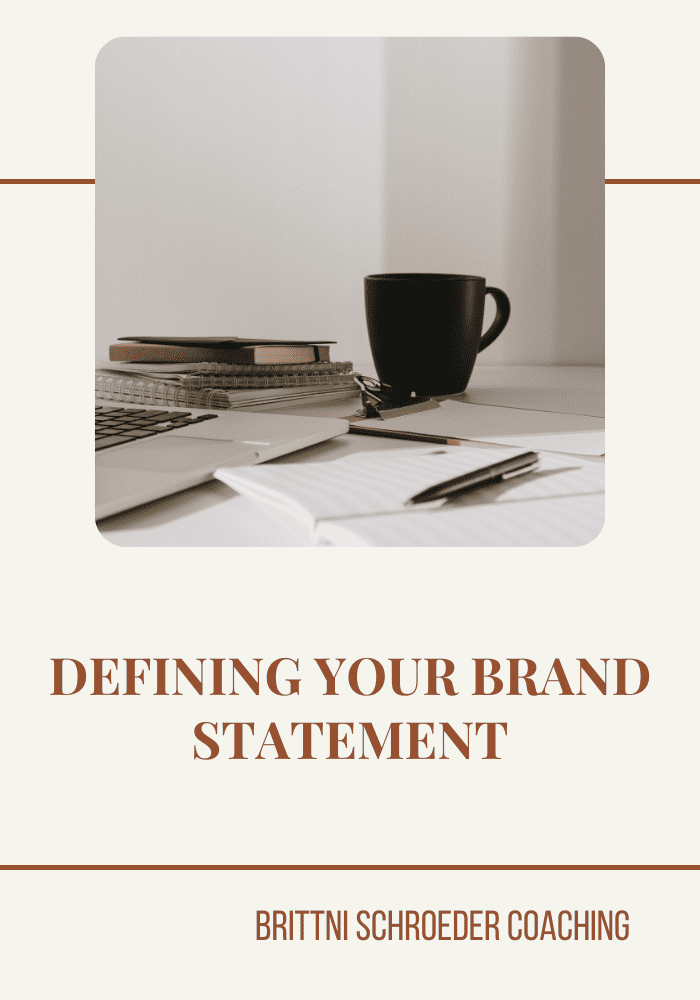brittni schroeder
BLOG
Brittni Schroeder Coaching
DEFINING YOUR BRAND STATEMENT

Businesses that have clarified their messaging and built a sales funnel are much more likely to succeed than those without clear brand messaging. A brand statement is a concise summary of what your business does, how you do it, and the results your clients can expect. Learning how to write a brand statement is essential to your business. In just a few sentences people should be able to understand you or what you do, how you do it, and the transformation you are offering. Defining your brand statement ensures you attract your ideal client.
The following are questions you should be able to answer about your business. Don’t worry if you can’t answer these right away. Take your time. This is going to be the heart of your business and the core for your marketing:
1. What do your customers/clients want?
2. What PROBLEM does your customer have that you are helping them solve?
3. How are you qualified to help them?
4. What is the plan that can solve this problem?
5. What is the CALL TO ACTION?
6. How will you help them avoid failure?
7. What RESULT will they get from using what you are offering?
8. What is the transformation?
WHAT DO THEY WANT?
Once you are clear on your ideal client, you will need to define what they want. The client is always the focus, not you or your brand. You want to make your brand statement about your clients, they are the hero in the story. When you define the outcome your client wants, you then will begin to connect with them through your marketing. Do they want more time, financial security, or a transformation? When we clearly define the desired outcome and feature it in our marketing, potential clients will become intrigued and want to know more.
THE PROBLEM
In order for a customer to really want a service or product, they need to know how it will help them. Companies sell solutions to external problems, but clients buy solutions to internal problems. The problem your service or product helps with can be internal (something they struggle with inside themselves) or external (something outside of them). You need to find the problem your client is having. Identifying the problem will help you connect with them. The more we talk about the client’s problems, the more interest they will have in your brand and the desire for you to help them.
There are two different types of problems: external and internal.
External problems is often a physical or tangible problem. This can be the need to lose weight, make money, get healthy, or a lack of knowledge or skill.
Internal problem can be considered a weakness, a flaw, the lack of, a shortcoming, failure, dysfunction, or a mistake. Internal problems often resemble lack of confidence, overwhelm, or confusion.
Often external problems lead to internal problems:
I want to lose weight, but don’t know how to do it.
I need to make more money, but I am not qualified for better opportunities.
I want to compete in a contest, but I am not good enough.
Internal problems are what motivate us to buy. Apple is a great example of this strategy. The external problem was people needing a computer and phone to communicate, take pictures, and create. The internal problem was people felt intimidated my all the tech talk and wanted a simpler way. Apple started selling the resolution to the problem of customer intimidation by creating simpler devices and using brand statements that reflected that.
HOW ARE YOU QUALIFIED?
Every hero needs a guide. You know how Luke Skywalker needed Yoda or Daniel needed Mr. Miyagi? Remember that everything is about your clients. People will lose interest if everything is about you. Your clients want to be seen, heard, and understood. In order to be a guide there are two things you need: empathy and authority.
When you express your empathy towards your clients’ frustrations and struggles, they will feel a connection. People yearn for support and understanding. They will see that you care and want what is best for them. Make sure empathy is authentic and expressed consistently in your brand statement.
As someone who is providing the guidance for a problem, you need authority. You want to have experience that positions you as an expert in your field. You want potential clients to trust and respect you. Authority is accomplished by testimonials, statistics, awards, recognition and achievements. Highlight your authority. Show the clients how you are qualified. Be sure to always frame your success as to how it benefits your clients.
THE PLAN
Once you recognize an area where you can help your clients, you want to provide a plan just for them. This plan will solve their unique problem. When you provide a roadmap of how this is going to be done, people are more likely to move forward. By creating a plan that creates clarity, you will simplify their journey and help them envision the desired outcome. They realize that they are capable of taking one step and at a time to get to where they want to go.
CALL TO ACTION
People like to be told what to do next and they need to be challenged. You want to make your call to action clear and repeat it over and over. Be bold and believe in what you are offering.
There are two different types of calls to actions. One is direct and the other is transitional. The direct call to action goes straight to the offer. It can be: Buy Now, Schedule a Call, or Sign Up now. This call of action is taken when a client is ready to go and doesn’t need any convincing.
Transitional call to action can be the process leading up to the sale. The transitional helps you position yourself as the expert. These calls to action can look like this: Join the Webinar, Grab Your Free Information, Try a Sample or Sign Up for our Free Trail.
A call to action is like a signature on a letter, it is a must. In order to move potential clients through the process, you have to tell them what to do next. This will move them one step closer to working with you or using your product.
AVOIDING FAILURE
Let your clients know what will happen if they don’t use you. What will they lose? People are more motivated to avoid loss than they are to receive gain. Briefly remind them of what will happen if they don’t do something about their current problem.
Here are some examples:
-You could be missing out on great opportunities
-Your wheels will keep spinning and you might become burned out and unmotivated
-You will find yourself living paycheck to paycheck with no end in sight
Don’t over-do the fear content, but briefly mention what will happen if they don’t move forward.
RESULTS
Share with your customer what results they can expect in their life because of your service. Let them know how their life will be better because of what you offer. Inform them of all the benefits that will come for them if they decide to use you. The results can be the win of power or position, relief of stress, more time, more money, or a transformation that makes them whole. Make sure you portray where the client experience will take them. Their desired outcome is something you will help them get.
TRANSFORMATION
Show your customers the possibilities of their transformation. We all have desire to evolve into something better, show them the possibilities. Use the terms “from_______ to_________” to help them see the possibilities.
-From confused to confidence
-From an overworked underpaid entrepreneur to a 20-hour a week industry leader
-From a tired mom to a fun, energetic adventurer
Once you have developed your brand statement, implement it in all your marketing. It should be your profile bio for all of your social media platforms, housed on your website and used consistently to draw in your ideal clients. Make defining your brand statement a priority in your business.
